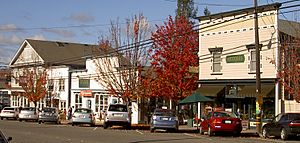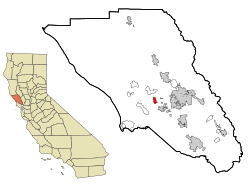Graton, California facts for kids
Quick facts for kids
Graton
|
|
|---|---|

Graton storefronts on north side of Graton Road between Ross Road and South Edison Street
|
|

Location in Sonoma County and the state of California
|
|
| Country | |
| State | |
| County | Sonoma |
| Area | |
| • Total | 1.579 sq mi (4.090 km2) |
| • Land | 1.579 sq mi (4.090 km2) |
| • Water | 0 sq mi (0 km2) 0% |
| Elevation | 108 ft (33 m) |
| Population
(2010)
|
|
| • Total | 1,707 |
| • Density | 1,081.1/sq mi (417.36/km2) |
| Time zone | UTC-8 (PST) |
| • Summer (DST) | UTC-7 (PDT) |
| ZIP code |
95444
|
| Area code(s) | 707 |
| FIPS code | 06-30812 |
| GNIS feature ID | 1658656 |
Graton is a small community in west Sonoma County, California, United States. It is known as a census-designated place (CDP). This means it's a special area that the government counts for population information, but it's not an officially incorporated city or town.
In 2010, about 1,707 people lived in Graton. Its ZIP code is 95444. The town is also known for its good food, thanks to some popular local restaurants. Graton is located about 20 miles (32 kilometers) from the California coastline. Historically, farmers in Graton grew many apples. Today, like much of Sonoma County, the area mostly focuses on growing grapes for wine.
Contents
Geography of Graton
Graton covers a total area of about 1.58 square miles (4.09 square kilometers). All of this area is land.
Location and Elevation
Graton is found at the southeastern end of Green Valley. It sits on the east side of Atascadero Creek. This creek can sometimes flood during certain seasons. The land in Graton is about 85 feet (26 meters) above sea level near the creek. It rises to about 213 feet (65 meters) above sea level near Oak Grove School.
Historical Russian Settlement
Graton is also important because it marks the southern and eastern edge of where the Russians settled in North America. Research on Fort Ross, a historic Russian fur trading fort on the coast, shows that several farms were built inland. These farms helped provide extra food and were used for farming experiments.
In 1836, a farm was set up along Purrington Creek. This creek is located between what are now the towns of Occidental and Graton. At this farm, a Russian expert named Yegor Chernykh built buildings and grew vegetables, fruits, wheat, and other grains. He also started a large vineyard, which was the beginning of grape growing in the area.
Graton's Climate
Graton has a type of weather called a warm-summer Mediterranean climate. This means it has warm, dry summers. The average monthly temperatures usually stay below 71.6°F (22°C). Winters are mild and wet. This climate is often called "Csb" on climate maps.
| Climate data for Graton (1991–2020 normals, extremes 1926–present) | |||||||||||||
|---|---|---|---|---|---|---|---|---|---|---|---|---|---|
| Month | Jan | Feb | Mar | Apr | May | Jun | Jul | Aug | Sep | Oct | Nov | Dec | Year |
| Record high °F (°C) | 84 (29) |
88 (31) |
90 (32) |
98 (37) |
103 (39) |
108 (42) |
113 (45) |
108 (42) |
114 (46) |
106 (41) |
92 (33) |
81 (27) |
114 (46) |
| Mean maximum °F (°C) | 69.9 (21.1) |
75.8 (24.3) |
80.6 (27.0) |
86.9 (30.5) |
91.0 (32.8) |
98.4 (36.9) |
98.4 (36.9) |
100.4 (38.0) |
100.2 (37.9) |
95.1 (35.1) |
82.5 (28.1) |
70.0 (21.1) |
103.5 (39.7) |
| Mean daily maximum °F (°C) | 58.0 (14.4) |
62.3 (16.8) |
65.9 (18.8) |
70.2 (21.2) |
75.2 (24.0) |
81.3 (27.4) |
82.6 (28.1) |
83.8 (28.8) |
83.7 (28.7) |
78.2 (25.7) |
66.8 (19.3) |
57.7 (14.3) |
72.1 (22.3) |
| Daily mean °F (°C) | 47.7 (8.7) |
50.7 (10.4) |
53.3 (11.8) |
56.2 (13.4) |
60.4 (15.8) |
64.8 (18.2) |
66.5 (19.2) |
67.1 (19.5) |
65.9 (18.8) |
61.2 (16.2) |
53.3 (11.8) |
47.2 (8.4) |
57.9 (14.4) |
| Mean daily minimum °F (°C) | 37.3 (2.9) |
39.0 (3.9) |
40.7 (4.8) |
42.2 (5.7) |
45.5 (7.5) |
48.3 (9.1) |
50.5 (10.3) |
50.3 (10.2) |
48.0 (8.9) |
44.2 (6.8) |
39.7 (4.3) |
36.8 (2.7) |
43.5 (6.4) |
| Mean minimum °F (°C) | 26.0 (−3.3) |
27.9 (−2.3) |
30.4 (−0.9) |
32.3 (0.2) |
36.5 (2.5) |
40.1 (4.5) |
42.9 (6.1) |
42.5 (5.8) |
39.1 (3.9) |
33.9 (1.1) |
28.0 (−2.2) |
25.5 (−3.6) |
23.4 (−4.8) |
| Record low °F (°C) | 18 (−8) |
17 (−8) |
25 (−4) |
25 (−4) |
29 (−2) |
33 (1) |
38 (3) |
36 (2) |
28 (−2) |
22 (−6) |
22 (−6) |
14 (−10) |
14 (−10) |
| Average precipitation inches (mm) | 7.88 (200) |
7.48 (190) |
5.18 (132) |
2.58 (66) |
1.41 (36) |
0.41 (10) |
0.01 (0.25) |
0.06 (1.5) |
0.18 (4.6) |
1.98 (50) |
4.43 (113) |
8.34 (212) |
39.94 (1,014) |
| Average precipitation days | 13.2 | 11.8 | 11.1 | 7.3 | 4.1 | 1.5 | 0.4 | 0.8 | 1.5 | 4.2 | 8.8 | 13.2 | 77.9 |
| Source: NOAA | |||||||||||||
People and Population in Graton
| Historical population | |||
|---|---|---|---|
| Census | Pop. | %± | |
| U.S. Decennial Census | |||
Graton's Population in 2010
According to the 2010 census, Graton had a population of 1,707 people. This means there were about 1,081 people living in each square mile (417 people per square kilometer).
Most of the people in Graton were White (82.1%). There were also smaller numbers of African American (0.6%), Native American (1.7%), and Asian (1.5%) residents. About 18.9% of the population identified as Hispanic or Latino.
Most people (99.2%) lived in regular homes. There were 680 households in total. The average household had about 2.49 people. The average family size was 3.03 people.
The median age in Graton was 45.9 years. This is older than the average age for all of California, which was 36.2 years. About 20.1% of the population was under 18 years old. About 13.9% of the population was 65 years or older.
Most homes (72.2%) were owned by the people living in them. The rest (27.8%) were rented. The median income for a household in Graton was $83,082. This was much higher than in 2000. The median income for a family was $87,641.
Notable People from Graton
Some well-known people have lived in Graton:
- George Segal – An actor and musician who was nominated for an Academy Award.
- Ned Kahn – An artist and sculptor who received a MacArthur Fellowship, a special award for talented individuals.
See also
 In Spanish: Graton (California) para niños
In Spanish: Graton (California) para niños


